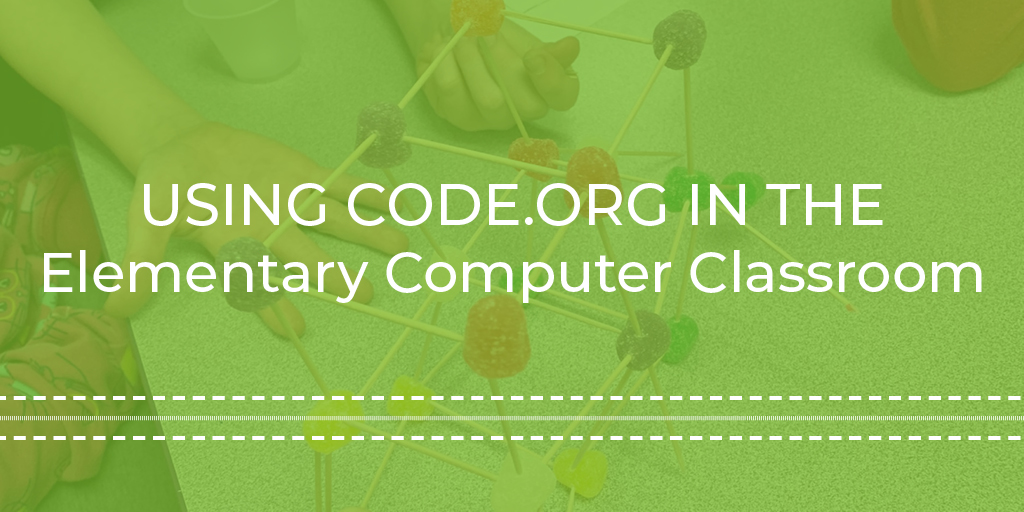
Back in September, I was sitting in a district computer teacher meeting discussing activities we used in our classrooms. My colleagues mentioned how they participate in the Hour of Code and other coding activities. Meanwhile, I was sliding down in my seat, embarrassed that I wasn’t doing the same cool activities as the others.
I have only been teaching computer class for five years, and I’m still learning how to balance life as a teacher/librarian as well as a technology instructor. Still, I want to do well on the technology side of my job. Instead of sitting around and feeling incompetent, I got online and found out more information about Code.org—an organization that sponsors the Hour of Code and a website that provides resources for teachers. Code.org also offers many professional development opportunities; I found a workshop close to home and signed up.
Getting Started
The class I took was beneficial in several ways. It was on a Saturday, so I earned PD points for going, and it was free. The five-hour session came complete with supplies to take home and lesson plans ready to use as soon as I returned to my building. During the session, I was able to ask the instructor questions and network with other technology teachers—some were newbies to coding like me, while others already had some experience in teaching students how to code. In addition, I was able to begin the process of setting up my fourth grade classes on Code.org while I was there. It was a great day, and I learned a lot about utilizing the Code.org website.
This was in November. Since then, I’ve taught several coding lessons to my third and fourth grade classes, and have just completed my first “unplugged” lesson with second graders. In the short time I’ve used Code.org, I’ve learned a lot—about coding, about learning, about myself, and about my students.
Let me share with you why I now believe that using Code.org to teach coding is a must in an elementary computer classroom:
- Code.org is an easy site to navigate. What I’ve found as a technology teacher is that my job requires a lot of exploring. I often have to go to a website, look around, figure out how to set up a class, and add students—all on my own. The Code.org workshop taught me how to utilize the Code.org website, although I think this site is user-friendly without instruction. The site is easy to navigate, which means it is easy to teach my students to navigate as well. As a teacher, I am able to go into every single lesson I would teach my students and do the lesson myself. This helps me, as I feel more prepared when I am taking students through a lesson. Setting up classes in Code.org is simple and just takes a few minutes. Plus, the login process for both a teacher and a student is also easy. All of these factors make Code.org a website that I want to use.
- Code.org has easy-to-follow, printable resources. When I taught my first few lessons, I needed reassurance and a step-by-step plan. Thankfully, Code.org had everything I needed to begin. I just had to click on the first lesson, which starts with a video to show the class. Then, I was able to print out the lesson plan (which included rationale for each piece of the lesson) as well as printables I would need to use during the lesson. Because of the plethora of resources Code.org contains, I was able to prepare for and teach my first few lessons with great success. I went step by step through the lesson plans, growing more comfortable with each class I taught.
- Code.org also allows for coding in pairs. I like that Code.org offers the option of coding with a partner. The site provides videos highlighting the benefits of coding in pairs. I think this is a nice feature for students who are struggling and feel more secure working with someone. Students may work on a coding lesson together, taking turns “driving” versus “navigating.” I find that coding often lends itself to discourse and consulting a neighbor for assistance. Thus, coding in pairs can be very effective. It’s a great way to start for anxious learners, and the collaboration aspect is a real-world skill. I’ve also found that students can learn from each other when working together. Each partner offers a unique perspective to solving the problem at hand, so partner coding can offer a win-win situation in the technology classroom.
- Students who struggle in other areas often excel at coding. I was told this in my Code.org training session, and I do think this statement is true. Sometimes the kids who excel academically get stuck when they learn to code, while other kids do better than you’d expect. I have one third grade student who usually needs a lot of reteaching and explanation. However, when we code, he problem solves and I often forget to even check on him because he’s so focused on his work. At the same time, I have a student who struggles with the unplugged coding lessons. She does fine working on the computer, but the group-centered, paper-pencil lessons throw her off. I think that the success vs. struggle aspect of coding makes it a valuable activity in that students learn to both persevere and to help others who are having difficulties.
- Code.org activities address the concept of fixed vs. growth mindset. I realize that Code.org was designed to help teachers promote computer science and encourage students to become interested in coding. However, this program does so much more. One unintended lesson via Code.org is growth mindset. These lessons are meant to provide opportunities for failure, struggle, and the joy of success. For example, I just taught “Lesson 1: Unplugged” to my second graders. As I introduced the lesson to the students, I defined two words and key concepts in the lesson: perseverance and frustration. We talked about both words, defined them, and gave examples. Then, students worked in groups to complete a task that was meant to be challenging. It was so interesting to see the students collaborate, design, test, and then redesign. Many of the structures they built failed, but they did not give up. The theme of the lesson was perseverance. And that is what they need to know about coding—when things get tough, it’s important to keep trying.
- Each Code.org lesson ends with a written reflection. This is one of my favorite features. For the last five or ten minutes of a Code.org lesson, for both plugged and unplugged activities, students are asked to reflect on what they learned or accomplished. This is fairly open-ended, allowing students to share what they liked, what they struggled with, what they thought was fun about the lesson, and so on. Along with the written reflection, they can draw a picture of the activity. I love this part because I’m able to read the reflections afterward, see what students thought about the lesson, and then figure out how I can tweak my teaching to make the lesson more effective. The reflection piece is a great teaching tool and method of communication between teacher and student.
- Finally, Code.org is fun for teachers and students. Allow me to nerd out for a minute and tell you how much I like learning how to teach coding. Before this school year, I had never tried coding and never really wanted to. But I did decide I wanted to keep up with my fellow technology teachers as well as enrich student learning—that’s why I attended the Code.org workshop in the first place. What I found, though, was that learning basic coding skills was fun and challenging in the best of ways. I never expected to enjoy teaching from Code.org, but I love it. I’ve enjoyed it so much that I can’t keep talking about it to co-workers. And my students love it, too. They understand that some lessons are going to be hard, but for the most part, my students have been willing to give coding a chance.
If you haven’t yet tried coding in the classroom, whether you’re a technology teacher or a classroom teacher, I’d suggest you give it a try—even if you think you’re not all that tech-savvy. Visit Code.org and find out about learning opportunities, or just jump in and explore the website. Once you start teaching coding and see the impact in your classroom, you’ll be glad you did!
Want to connect with fellow educators to discuss coding and other teaching trends? Consider joining MimioConnect™, our interactive teaching community!


